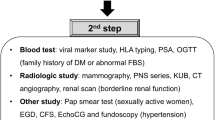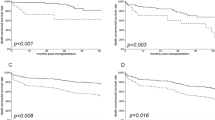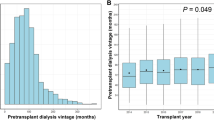Abstract
The number of patients with end-stage renal disease is increasing substantially every year around the world. Renal transplantation is the best treatment option to improve survival and quality of life. Although the numbers of living, related and deceased transplant donors has also increased, this growth is insufficient to keep up with the expansion rate of the renal failure population. The introduction of laparoscopic donor nephrectomy has gained widespread acceptance by physicians and patients, and seems to be better than open donor nephrectomy in terms of reduced postoperative pain, quick recovery and improved cosmetic outcomes. Evidence strongly suggests that graft survival is similar in recipients of kidneys from living related and unrelated donors. Fortunately, this information has raised awareness of the suitability of potential live, unrelated donors, including spouses, friends, or even anonymous donors. In this Review we touch on sociological aspects of living related kidney transplantation and review the available and proposed methods of increasing the live donor pool, including organ exchange and desensitization protocols for ABO-incompatible and cross-match-positive donor pairs.
Key Points
-
Renal transplantation yields the optimum survival and quality of life in patients with end-stage renal disease; however, the donor population is insufficient to meet the growing need for organs
-
Laparoscopic donor nephrectomy has gained widespread acceptance with surgeons and potential donors, and is better than open donor nephrectomy in terms of reduced postoperative pain, quick recovery and improved cosmetic outcomes
-
Kidney donation carries notable psychological and sociological burdens; education and support for donors and recipients regarding potential pitfalls can ensure a smooth transition into normal life
-
Various programs are available worldwide that aim to overcome the problems facing ABO-incompatible or cross-match-positive donor–recipient pairs, including organ exchange and desensitization protocols involving aggressive plasmapheresis, high-dose immunosuppression and/or splenectomy
-
Some important ethical concerns about the different approaches to widening the donor pool remain to be resolved
This is a preview of subscription content, access via your institution
Access options
Subscribe to this journal
Receive 12 print issues and online access
$209.00 per year
only $17.42 per issue
Buy this article
- Purchase on Springer Link
- Instant access to full article PDF
Prices may be subject to local taxes which are calculated during checkout
Similar content being viewed by others
References
US Renal Data System (2003) USRDS 2003 Annual Data Report. Bethesda, MD: National Institutes of Health, National Institute of Diabetes and Digestive and Kidney Diseases
Wolfe RA et al. (1999) Comparison of mortality in all patients on dialysis, patients on dialysis awaiting transplantation and recipients of a first cadaveric transplant. N Engl J Med 431: 1725–1730
Schnuelle P et al. (1989) Impact of renal cadaveric transplantation on survival in end-stage renal failure: evidence for reduced mortality risk compared with hemodialysis during long-term follow-up. J Am Soc Nephrol 9: 2135–2141
Port FK et al. (1993) Comparison of survival probabilities for dialysis patients vs cadaveric renal transplant recipients. JAMA 270: 1339–1343
Laupacis A et al. (1996) A study of the quality of life and cost-utility of renal transplantation. Kidney Int 50: 235–242
Russell JD et al. (1992) The quality of life in renal transplantation—a prospective study. Transplantation 54: 656–660
Eggers PW (1988) Effect of transplantation on the Medicare end-stage renal disease program. N Engl J Med 318: 223–229
US Renal Data System (2002) USRDS 2002 Annual Data Report. Bethesda, MD: National Institutes of Health, National Institute of Diabetes and Digestive and Kidney Diseases
Hariharan S et al. (2000) Improved graft survival after renal transplantation in the United States, 1988 to 1996. N Engl J Med 342: 605–612
Terasaki PI et al. (1995) High survival rates of kidney transplants from spousal and living unrelated donors. N Engl J Med 333: 333–336
Davis CL and Delmonico FL (2005) Living-donor kidney transplantation: a review of the current practices for the live donor. J Am Soc Nephrol 16: 2098–2110
Ratner LE et al. (1995) Laparoscopic live donor nephrectomy. Transplantation 60: 1047–1049
Schweitzer EJ et al. (2000) Increased rates of donation with laparoscopic donor nephrectomy. Ann Surg 232: 392–400
Matas AJ et al. (2003) Morbidity and mortality after living kidney donation, 1999–2001: survey of United States transplant centers. Am J Transplant 3: 830–834
Abrahams HM et al. (2004) Laparoscopic donor nephrectomy for pediatric recipients: outcomes analysis. Urology 63: 163–166
Friedman AL et al. (2006) Fatal and nonfatal hemorrhagic complications of living kidney donation. Ann Surg 243: 126–130
Kok NF et al. (2006) Comparison of laparoscopic and mini incision open donor nephrectomy: single blind, randomised controlled trial. BMJ 333: 221
Flowers JL et al. (1997) Comparison of open and laparoscopic live donor nephrectomy. Ann Surg 226: 483–489
Nogueira JM et al. (1999) A comparison of recipient renal outcomes with laparoscopic versus open live donor nephrectomy. Transplantation 67: 722–728
El-Galley R et al. (2004) Donor nephrectomy: a comparison of techniques and results of open, hand assisted and full laparoscopic nephrectomy. J Urol 171: 40–43
Martin GL et al. (2007) Laparoscopic donor nephrectomy: effects of learning curve on surgical outcomes. Transplant Proc 39: 27–29
Hadjianastassiou VG et al. (2007) 2,509 living donor nephrectomies, morbidity, mortality, including the UK introduction of laparoscopic donor surgery. Am J Transplant 7: 2532–2537
Challacombe B et al. (2005) Telementoring facilitates independent hand-assisted laparoscopic living donor nephrectomy. Transplant Proc 37: 613–616
Martin RC Jr et al. (2005) Formal training in advanced surgical technologies enhances the surgical residency. Am J Surg 190: 244–248
Horgan S et al. (2002) Robotic-assisted laparoscopic donor nephrectomy for kidney transplantation. Transplantation 73: 1474–1479
Modi P et al. (2007) Obtaining cuff of inferior vena cava by use of the Endo-TA stapler in retroperitoneoscopic right-sided donor nephrectomy. Urology 69: 832–834
Simforoosh N et al. (2007) Right laparoscopic donor nephrectomy and the use of inverted kidney transplantation: an alternative technique. BJU Int 100: 1347–1350
El-Galley R (2007) Novel technique for hand assisted laparoscopic right donor nephrectomy. J Urol 178: 2062–2066
Maciel RF (2007) Hand-assisted laparoscopic live donor nephrectomy (right sided approach): experience obtained from 31 cases. Transplant Proc 39: 2476–2477
Merlin TL et al. (2000) The safety and efficacy of laparoscopic live donor nephrectomy: a systematic review. Transplantation 70: 1659–1666
Yuzawa K et al. (2006) Outcome of laparoscopic live donor nephrectomy in 2005: national survey of Japanese transplant centers. Transplant Proc 38: 3409–3411
Franklin PM and Crombie AK (2003) Live related renal transplantation: psychological, social and cultural issues. Transplantation 76: 1247–1252
Troppmann C et al. (2006) Impact of laparoscopic nephrectomy on donor preoperative decision-making and postoperative quality of life and psychosocial outcomes. Pediatr Nephrol 21: 1052–1054
Jacobs C et al. (1998) Kidney transplants from living donors: how donation affects family dynamics. Adv Ren Replace Ther 5: 89–97
Westlie L et al. (1993) Quality of life in Norwegian kidney donors. Nephrol Dial Transplant 8: 1146–1150
Fox RC and Swazey JP (1992) Spare parts: organ replacement in American society. New York, NY: Oxford University Press
Pradel FG et al. (2003) Patients' attitudes about living donor transplantation and living donor nephrectomy. Am J Kidney Dis 41: 849–858
Baines LS et al. (2001) Relationship between donors and pediatric recipients of kidney transplant: a psychosocial study. Transplant Proc 33: 1897–1899
Ku JH (2005) Health-related quality of life of living kidney donors: review of the short form 36-health questionnaire survey. Transplant Int 18: 1309–1317
Ware JE Jr and Sherbourne CD (1992) The MOS 36-item short-form health survey (SF-36). I. Conceptual framework and item selection. Med Care 30: 473–483
Zargooshi J (2001) Quality of life of Iranian kidney “donors”. J Urol 166: 1790–1799
Fehrman-Ekholm I et al. (2000) Kidney donors don't regret: follow-up of 370 donors in Stockholm since 1964. Transplantation 69: 2067–2071
Isotani S et al. (2002) Quality of life of living kidney donors: the short-form 36-item health questionnaire survey. Urology 60: 588–592
Johnson EM et al. (1999) Long-term follow-up of living kidney donors: quality of life after donation. Transplantation 67: 717–721
Buell JF et al. (2005) Laparoscopic donor nephrectomy vs open live donor nephrectomy: a quality of life and functional study. Clin Transplant 19: 102–109
Chen CH et al. (2004) Risks and quality-of-life changes in living kidney donors. Transplant Proc 36: 1920–1921
Perry KT et al. (2003) Quality of life, pain and return to normal activities following laparoscopic donor nephrectomy versus open mini-incision donor nephrectomy. J Urol 169: 2018–2021
Zimmerman D et al. (2000) Gender disparity in living renal transplant donation. Am J Kidney Dis 36: 534–540
Kayler LK et al. (2003) Gender imbalance and outcomes in living donor renal transplantation in the United States. Am J Transplant 3: 452–458
Tuohy KA et al. (2006) Gender disparities in the live kidney donor evaluation process. Transplantation 82: 1402–1407
OPTN/SRTR (online 2006) 2006 OPTN/SRTR Annual Report: transplant data 1996–2005. [http://www.optn.org/AR2006/default.htm] (accessed 3 January 2008)
Delmonico FL et al. (2005) Organ donation and utilization in the United States, 2004. Am J Transplant 5: 862–873
Cecka JM (2003) The OPTN/UNOS renal transplant registry. Clin Transplant 1–16
Gjertson DW (2003) Look-up survival tables for living-donor renal transplants: OPTN/UNOS data 1995–2002. Clin Transplant 337–386
Segev DL et al. (2005) Kidney paired donation and optimizing the use of live donor organs. JAMA 293: 1883–1890
Mahendran AO and Veitch PS (2007) Paired exchange programmes can expand the live kidney donor pool. Br J Surg 94: 657–664
Rapaport FT (1986) The case for living emotionally related international kidney donor registry. Transplant Proc 18 (Suppl 2): 5–9
Delmonico FL et al. (2004) Donor kidney exchanges. Am J Transplant 4: 1628–1634
Kwak JY et al. (1999) Exchange-donor program in renal transplantation: a single center experience. Transplant Proc 31: 344–345
Kranenburg LW et al. (2006) One donor, two transplants: willingness to participate in altruistically unbalanced exchange donation. Transpl Int 19: 995–999
Keizer KM et al. (2005) The Dutch algorithm for allocation in living donor kidney exchange. Transplant Proc 37: 589–591
de Klerk M et al. (2007) Favorable results of the first two years of the Dutch paired, living donor, kidney exchange program [Dutch]. Ned Tijdschr Geneeskd 151: 130–133
Montgomery RA et al. (2006) Domino paired kidney donation: a strategy to make best use of live non-directed donation. Lancet 368: 419–421
Park JH et al. (2004) Relay kidney transplantation in Korea—legal, ethical and medical aspects. Leg Med (Tokyo) 6: 178–181
Montgomery RA et al. (2005) Clinical results from transplanting incompatible living kidney donor/recipient pairs using kidney paired donation. JAMA 294: 1655–1663
Waterman AD et al. (2006) Incompatible kidney donor candidates' willingness to participate in donor-exchange and non-directed donation. Am J Transplant 6: 1631–1638
Montgomery RA et al. (2003) Renal transplantation at the Johns Hopkins Comprehensive Transplant Center. Clin Transplant 199–213
Mannami M and Mitsuhata N (2005) Improved outcomes after ABO-incompatible living-donor transplantation after 4 weeks of treatment with mycophenolate mofetil. Transplantation 79: 1756–1758
Kaplan B et al. (2007) Successful rescue of refractory, severe antibody mediated rejection with splenectomy. Transplantation 83: 99–100
Gloor JM et al. (2003) Overcoming a positive crossmatch in living donor kidney transplantation. Am J Transplant 3: 1017–1023
Sonnenday CJ et al. (2004) Plasmapheresis, CMV hyperimmune globulin and anti-CD20 allow ABO incompatible renal transplantation without splenectomy. Am J Transplant 4: 1315–1322
Gloor JM et al. (2003) ABO-incompatible kidney transplantation using both A2 and non-A2 living donors. Transplantation 75: 971–977
Simpkins CE et al. (2004) Improved results with selective use of splenectomy and anti-CD20 for positive crossmatch transplants [abstract]. Transplantation 78 (Suppl 1): 27
Author information
Authors and Affiliations
Corresponding author
Ethics declarations
Competing interests
The authors declare no competing financial interests.
Rights and permissions
About this article
Cite this article
Sener, A., Cooper, M. Live donor nephrectomy for kidney transplantation. Nat Rev Urol 5, 203–210 (2008). https://doi.org/10.1038/ncpuro1047
Received:
Accepted:
Published:
Issue Date:
DOI: https://doi.org/10.1038/ncpuro1047
This article is cited by
-
Long-term health-related quality of life of living kidney donors: a single-center experience
Quality of Life Research (2015)
-
Multidetector computed tomography with triple-bolus contrast medium administration protocol for preoperative anatomical and functional assessment of potential living renal donors
European Radiology (2010)



